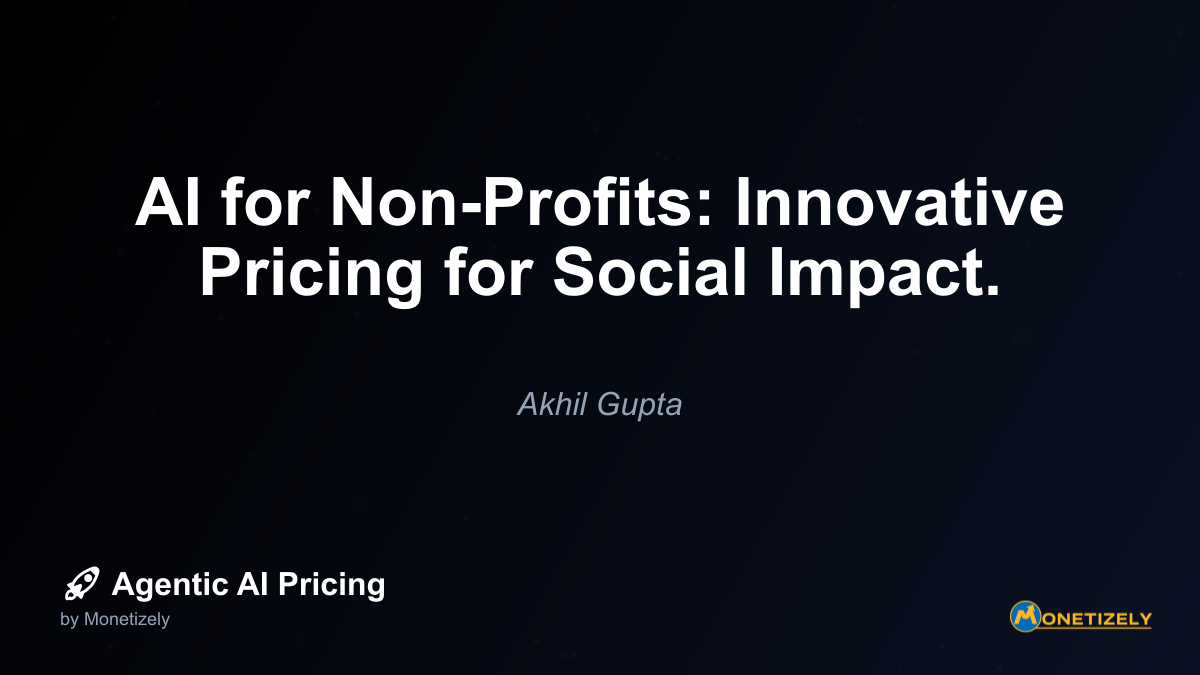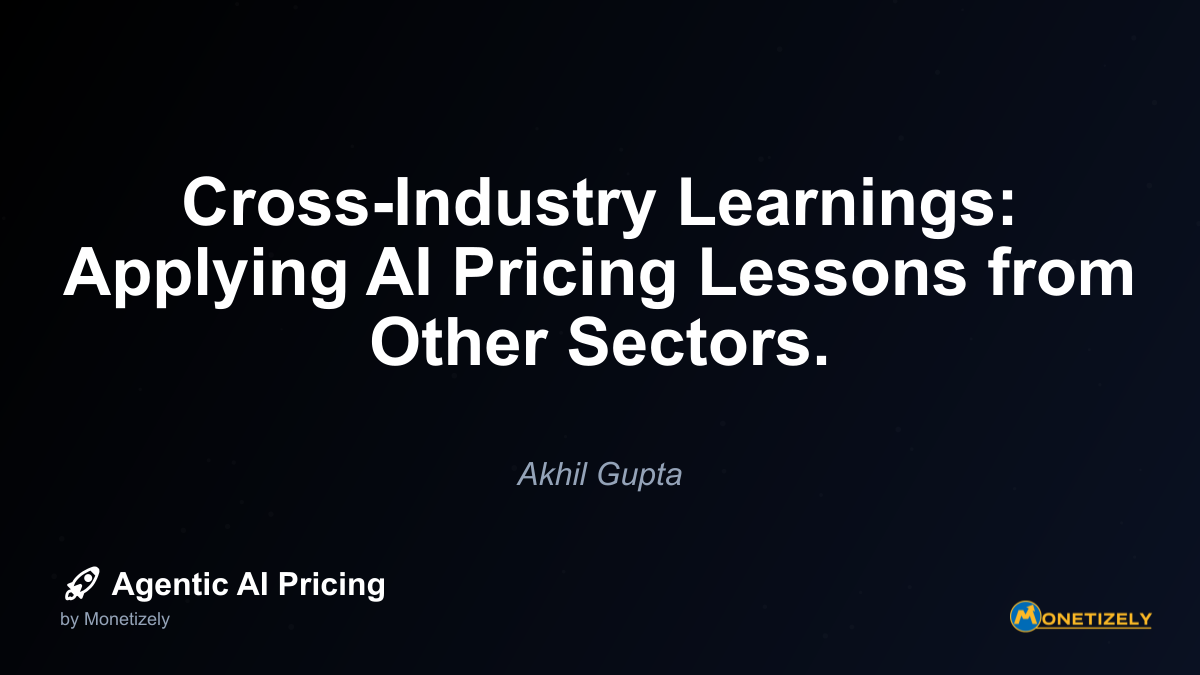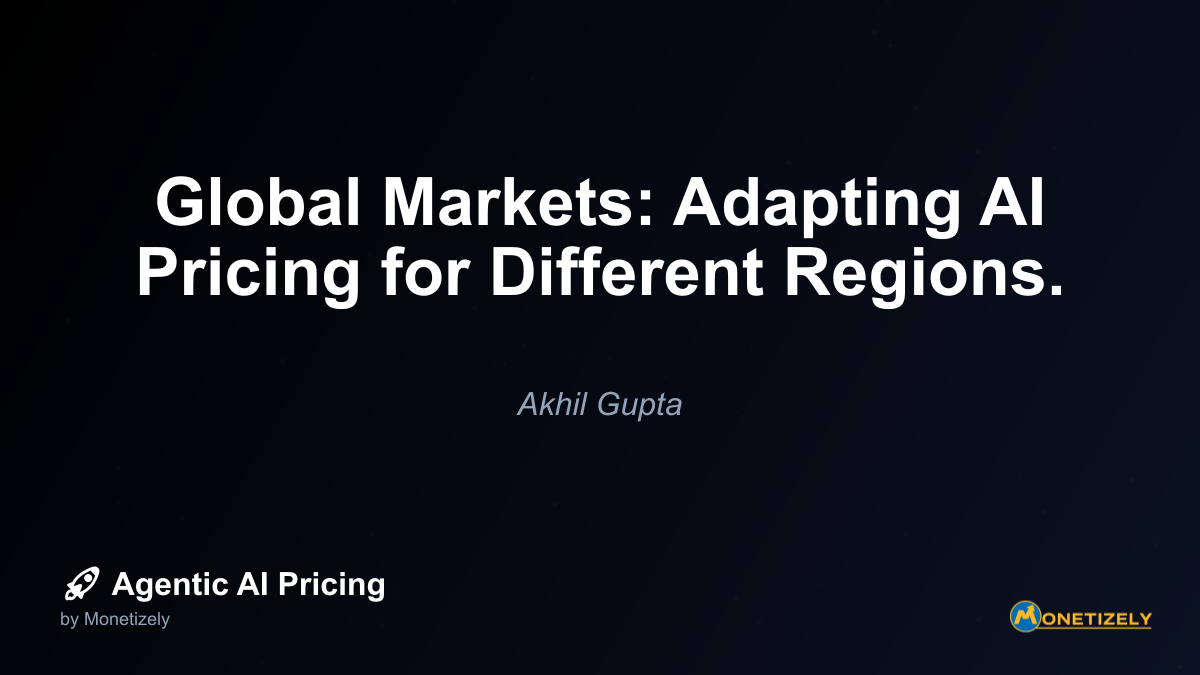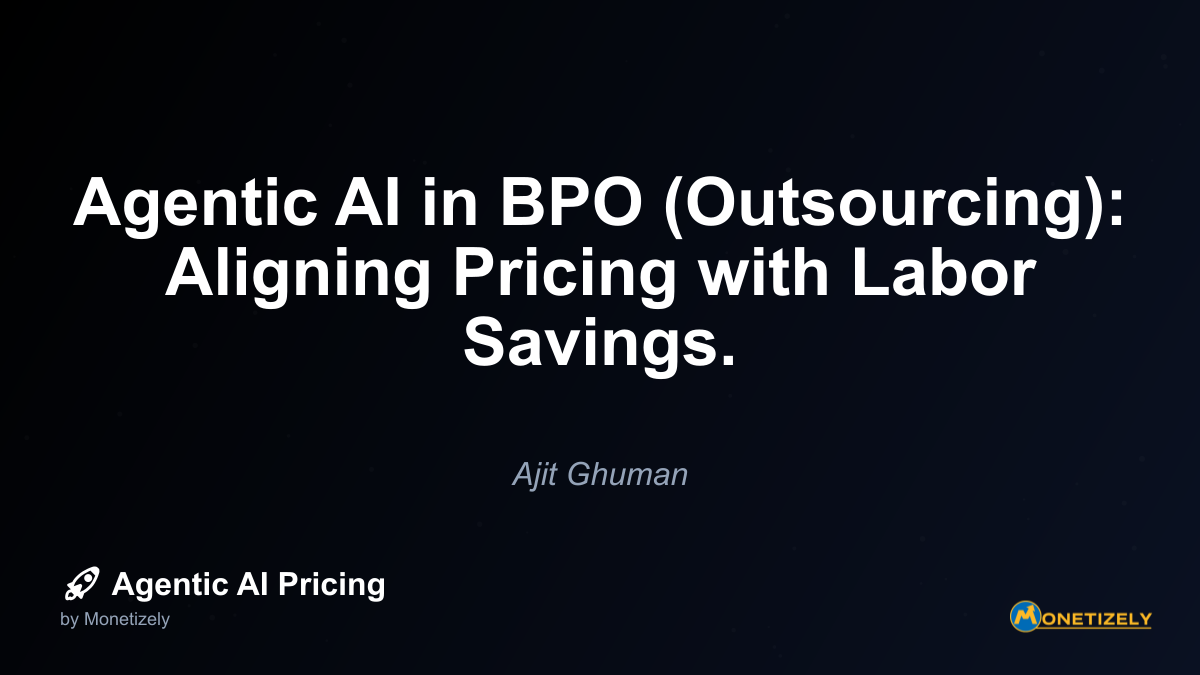· Akhil Gupta · Industry Insights · 9 min read
AI for Non-Profits: Innovative Pricing for Social Impact.
AI and SaaS Pricing Masterclass
Learn the art of strategic pricing directly from industry experts. Our comprehensive course provides frameworks and methodologies for optimizing your pricing strategy in the evolving AI landscape. Earn a professional certification that can be imported directly to your LinkedIn profile.

AI has revolutionized countless industries, and the non-profit sector stands to benefit tremendously from these technological advances. However, the traditional pricing models that work for corporate clients often create insurmountable barriers for organizations dedicated to social good. Fortunately, a new wave of innovative pricing strategies is emerging specifically designed to make powerful AI tools accessible to those working toward positive social change.
The AI Accessibility Gap in the Non-Profit Sector
Non-profit organizations face unique challenges when implementing new technologies. Limited budgets, restricted grant funding for technology, and lean operational teams create significant barriers to AI adoption. While commercial entities can justify AI investments through projected ROI, non-profits measure success through social impact metrics that are often harder to quantify in financial terms.
According to a recent survey by NetHope, over 60% of non-profit organizations identify cost as the primary obstacle to implementing AI solutions. This creates an “innovation gap” where those organizations potentially benefiting most from efficiency-driving technologies are the least able to access them.
This gap is particularly concerning given the transformative potential of AI for social impact work:
- Automating administrative tasks to redirect human resources toward mission-critical activities
- Analyzing complex data sets to better understand societal challenges
- Personalizing outreach and donor communications
- Optimizing resource allocation in humanitarian response
- Scaling services to underserved populations
Why Traditional AI Pricing Models Fail Non-Profits
The standard pricing structures for enterprise AI solutions typically follow several models:
- Per-seat licensing: Charging based on the number of users
- Usage-based pricing: Fees structured around API calls, processing time, or data volume
- Tiered subscription models: Monthly or annual fees for access to different capability levels
- Enterprise agreements: Custom contracts with minimum commitments
These models present specific challenges for non-profits:
Unpredictable budgeting: Usage-based pricing creates uncertainty for organizations with strict grant-based funding that requires precise budget forecasting.
Scale penalties: As non-profits grow their impact, traditional pricing models often penalize their success with higher costs.
Feature bloat: Enterprise packages include advanced capabilities designed for corporate needs but irrelevant to many non-profit use cases.
Procurement complexity: Many non-profits lack dedicated IT procurement specialists to navigate complex enterprise agreements.
Emerging Pricing Innovations for Social Impact AI
Recognizing these challenges, forward-thinking AI providers are developing alternative pricing approaches specifically designed for the non-profit sector:
1. Impact-Adjusted Pricing
This model scales costs based on the organization’s size, budget, or impact reach rather than usage volume. A small community organization might pay significantly less than a large international NGO for the same AI capabilities.
Example: Salesforce.org’s Nonprofit Cloud offers its Einstein AI capabilities on a sliding scale based on annual operating budget, with organizations under $1M receiving up to 80% discounts on standard rates.
2. Pay-What-You-Can Models
Some providers have adopted flexible payment structures allowing organizations to contribute what they can afford while maintaining full access to the technology.
Example: OpenAI has experimented with pay-what-you-can access to GPT models for verified non-profit research teams, particularly those working in areas like climate change and public health.
3. Corporate Sponsorship Programs
An innovative approach involves for-profit companies subsidizing AI access for aligned non-profits as part of their corporate social responsibility initiatives.
Example: Microsoft’s AI for Good program provides Azure AI credits and technical support to non-profits working in areas like environmental sustainability, humanitarian action, and accessibility.
4. Consortium Pricing
Multiple non-profits with similar missions can pool resources to collectively negotiate better rates with AI providers, sharing both costs and implementation insights.
Example: The Global Emancipation Network, a collective of anti-human trafficking organizations, secured preferential pricing for AI-powered investigation tools through collective bargaining.
5. Grant-Funded Access
Some AI providers partner with foundations to offer grant-funded access to their platforms, removing the direct cost burden from non-profits entirely.
Example: Google.org’s AI for Social Good program provides both financial grants and Google Cloud credits to non-profits developing AI solutions for humanitarian challenges.
Case Studies: Successful AI Pricing Models for Social Impact
Case Study 1: Humanitarian Mapping with Subsidized Computer Vision
When natural disasters strike, rapid mapping of damaged areas is critical for effective response. Traditional methods relied on slow manual analysis of satellite imagery. An AI startup specializing in computer vision developed a solution that could automatically identify damaged structures, blocked roads, and flooded areas from satellite imagery.
Rather than applying their standard usage-based pricing model, the company created a “disaster response pricing tier” that activates automatically when international humanitarian emergencies are declared. During these periods, humanitarian organizations receive unlimited API access for affected regions at a 95% discount, with costs subsidized by the company’s commercial clients who opted into a “disaster response contribution” on their contracts.
This model has enabled rapid deployment of AI-assisted mapping in over 20 major disasters, reducing the time to create usable maps from days to hours.
Case Study 2: Mental Health Support Through Consortium Pricing
A network of 50 community mental health organizations formed a technology consortium to negotiate access to an AI-powered therapy support tool. The platform uses natural language processing to analyze session transcripts, identify potential crisis indicators, and suggest evidence-based intervention strategies.
While the commercial version costs $200 per clinician monthly, the consortium secured a flat annual fee structure that reduced per-organization costs by over 70%. The agreement included a “success sharing” component where the vendor receives bonus payments when measurable outcome improvements are documented.
This approach has made sophisticated AI support accessible to smaller community clinics that could never afford the technology individually, resulting in improved care coordination for over 100,000 vulnerable patients.
Case Study 3: Environmental Conservation Through Corporate Sponsorship
An AI system designed to detect illegal logging through acoustic monitoring presented a perfect use case for environmental non-profits, but its deployment costs were prohibitive. The solution provider partnered with a major timber products company seeking to demonstrate commitment to sustainable forestry.
The resulting program allowed non-profits to apply for fully-sponsored implementations in high-risk forest regions. The corporate sponsor covered all technology costs while gaining reputational benefits and valuable sustainability metrics for their ESG reporting. Non-profits received cutting-edge technology without diverting limited resources from their core conservation work.
This model has protected over 50,000 hectares of vulnerable forest while creating a sustainable funding stream for the technology provider that doesn’t depend on extracting fees from resource-constrained conservation groups.
Best Practices for Implementing Innovative AI Pricing for Social Good
For AI providers looking to develop more inclusive pricing models for the social sector, several key principles should guide your approach:
1. Understand True Value Creation
Before designing pricing models, deeply understand how your AI solution creates value specifically in non-profit contexts. The metrics that matter may differ significantly from commercial applications:
- Time saved for overextended staff
- Increased reach to vulnerable populations
- Improved accuracy of interventions
- Enhanced donor engagement and transparency
2. Design for Budget Certainty
Non-profits operate under strict funding constraints with limited flexibility. Pricing models that provide budget predictability are strongly preferred:
- Fixed annual costs aligned with grant cycles
- Capped usage models with clear maximum expenditures
- Multi-year agreements that synchronize with funding timelines
3. Scale Pricing to Organizational Capacity
Create sliding scales based on meaningful organizational metrics:
- Annual operating budget
- Number of beneficiaries served
- Geographic scope (local, regional, national, international)
- Staff size or volunteer base
4. Build Evaluation Partnerships
Rather than simply discounting services, consider collaborative approaches that advance both business and social goals:
- Offer reduced pricing in exchange for case study development
- Create joint research initiatives to document social impact
- Develop shared IP that benefits both commercial and social applications
5. Leverage Existing Funding Mechanisms
Design pricing models that align with how non-profits already receive and deploy funding:
- Create packages specifically structured for common grant requirements
- Develop documentation templates for technology-focused foundation proposals
- Offer deferred payment options that accommodate reimbursement-based grants
Measuring Success: Beyond Revenue Metrics
For AI companies implementing innovative social impact pricing, success should be measured through multiple lenses:
1. Expanded Market Reach
While individual non-profit clients may generate less revenue, they collectively represent a massive sector. Over 1.5 million non-profit organizations exist in the US alone, with combined annual revenues exceeding $2 trillion.
2. Product Evolution
Non-profit applications often drive innovation in unexpected directions. Their unique use cases can lead to product improvements benefiting all customers.
3. Mission Alignment
For many AI companies founded with transformative goals, enabling social impact directly fulfills their core mission beyond profit generation.
4. Employee Engagement
Teams working on social impact applications frequently report higher job satisfaction and retention, creating indirect business value.
5. Partnership Opportunities
Relationships with non-profit organizations often lead to unexpected collaborations, including access to unique datasets, domain experts, and public funding streams.
Future Trends in AI Social Impact Pricing
As the field evolves, several emerging trends will likely shape how AI is priced for social impact:
1. Impact-Based Pricing
Future models may directly tie costs to measurable social outcomes, with pricing adjusted based on documented impact.
2. Hybrid Human-AI Service Models
Combined offerings where technology providers include human support specifically designed for non-profit implementation challenges.
3. Open Source Foundations with Premium Services
Core AI capabilities provided through open source foundations while specialized features and support offered through paid tiers.
4. Cross-Sector Data Cooperatives
Shared data resources between commercial and non-profit entities with preferential pricing for organizations contributing to the common data pool.
5. Public-Private Partnerships
Government agencies increasingly subsidizing AI access for non-profits addressing priority social challenges through formal procurement programs.
Conclusion: Aligning AI Pricing with Social Purpose
The transformative potential of AI for addressing humanity’s greatest challenges cannot be realized if pricing models exclude the very organizations dedicated to social change. By reimagining how we value and price AI capabilities for the social sector, technology providers can simultaneously expand their market reach and maximize their positive impact.
The most successful approaches recognize that different metrics of value apply in social contexts. Rather than simply discounting standard commercial offerings, truly innovative pricing models are designed from the ground up to align with non-profit operational realities.
For non-profit leaders, these emerging models open new possibilities for technological empowerment without compromising financial sustainability. By seeking out providers offering these flexible approaches—and clearly communicating their unique constraints and value metrics—organizations can accelerate their adoption of transformative AI tools.
As the field matures, we can expect continued innovation in how AI is made accessible for social good, creating a more inclusive technological future where the benefits of artificial intelligence extend to all sectors of society, regardless of their ability to pay commercial rates.
Co-Founder & COO
Akhil is an Engineering leader with over 16+ years of experience in building, managing and scaling web-scale, high throughput enterprise applications and teams. He has worked with and led technology teams at FabAlley, BuildSupply and Healthians. He is a graduate from Delhi College of Engineering and UC Berkeley certified CTO.
Pricing Strategy Audit
Let our experts analyze your current pricing strategy and identify opportunities for improvement. Our data-driven assessment will help you unlock untapped revenue potential and optimize your AI pricing approach.




